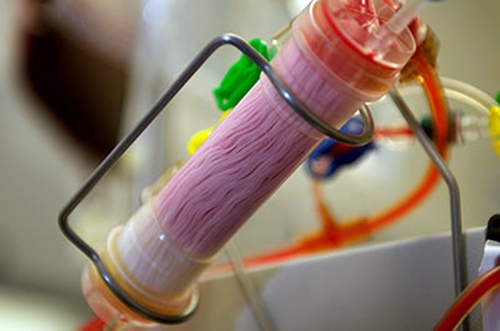9 October 2015. A new enterprise spun-off from Harvard University is developing a device for treating sepsis, a life-threatening infection often contracted in hospitals. The company, Opsonix Inc. in Boston, also raised $8 million in its first round of venture funding.
Opsonix is licensing a technology for treating sepsis developed in Harvard’s Wyss Institute for Biologically Inspired Engineering. Sepsis results from an immune-system reaction to chemicals released by the body to fight infection, including infections from medical equipment such as catheters. The inflammatory responses can occur anywhere in the body and generate a series of further reactions, including blood clots and leaking blood vessels, causing organ damage and failure.
If sepsis develops into septic shock, blood pressure drops sharply, often causing death. Centers for Disease Control and Prevention says the number of people in U.S. hospitals with sepsis rose from 621,000 in 2000 to more than 1.1 million in 2008, with death resulting in 28 to 50 percent of cases.
Ospnix’s technology, first developed by Wyss Institute staff scientist Michael Super, is based on an engineered molecule acting like a natural protein known as mannose-binding lectin that binds to carbohydrates found in a broad range of bacteria and viruses including those associated with sepsis. Super genetically engineered mannose-binding lectin to combine with antibody molecules to combat invading pathogens.
With colleagues at Harvard and its affiliated hospitals as well as MIT, Super coated nanoscale beads with the engineered mannose-binding lectin, then magnetized the coated beads to attract microbes and toxins. The team packed the beads into a device that acts like a spleen to clean the blood. In proof-of-concept tests with lab rats reported last year in the journal Nature Medicine, the artificial spleen cleared 90 percent of the Staphylococcus aureus and E. coli bacteria, and increased survival rates from toxins generated by the bacteria after a 5-hour treatment.
For humans, Super infuses fibers like those used in dialysis machines with the magnetic protein-coated beads, configured into an artificial spleen device that cleans patients’ blood. In a preclinical study testing the device on whole blood and lab animals, reported in the October 2015 issue of the journal Biomaterials, the device removed 90 to 99 percent of pathogens and toxins. The study shows as well that a 2-hour treatment with the device can clear lab animals of pathogens and toxins, reducing the inflammatory responses leading to septic shock, while comparable animals treated with antibiotics alone continued to suffer with high pathogen and toxin levels.
Super and Wyss Institute director Donald Ingber founded Opsonix, which licensed the blood cleansing technology from Harvard. Yesterday, the company revealed it raised $8 million its first venture financing round, led by Baxter Ventures, the venture capital arm of Baxter International. Because the device can remove a broad range of pathogens, Super and Ingber believe their invention can be used earlier than current antibiotics that require more certainty as to the precise type of infection, and thus save more lives of people with sepsis infections.
Read more:
- MD Anderson, Biotech Form Antibody Discovery Company
- Spin-Off Formed to Develop Brain Disorder Therapies
- Allied-Bristol Licensing Immunotherapy Technology
- Biomedical Accelerator Accepts 12 New Research Projects
- Univ. Research Execs See Science Economic Benefits
* * *


 RSS - Posts
RSS - Posts
[…] Harvard Spin-Off Commercializing Sepsis Treatment […]